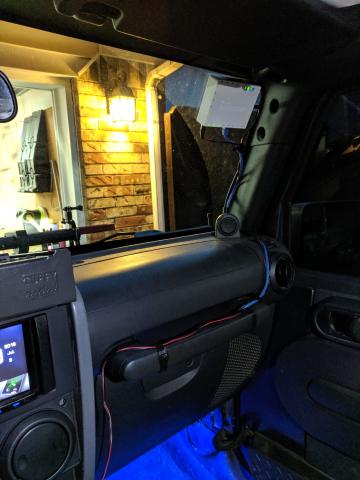This isn't a traditional GoKit but I wanted to show this and get any feedback. I'm calling this whole setup (which may expand into an app) OMSAT - Open Mobile Situational Awareness Tool Kit.
Setup
I rigged up a few of these Mikrotiks in various off-road vehicles and we went driving around a national forest and saw how they performed.

You can see I mounted it to the upper corner of the windshield. Not pictured is the beaglebone linux server in the glove compartment running a mumble server.
Also not pictured is the smartphone running a mumble app linked to the entertainment system to provide full vehicle VoIP comms.
I was really wanting to see how this operated in a forest environment and overall was pleased. The vegetation was thick and the range varied from 10 feet to a few hundred feet.
Results
The group chatting quality overall was good, not dropping too many packets of the conversation. We played with the settings a little, switching to TCP and larger packet sizes to maybe force the mumble protocol to handle packet loss a little better (we got to the point where we would rather have more latency than losing a word or two from a sentence). It was hard to tell if the settings had an effect, with how dynamic the environment was.
Future Improvements
If we put a node inside every vehicle of the convoy I'm not sure we would need to do any hardware modifications. At some points there was an extra vehicle in-between two node vehicles. We of course could rig up an external antenna or just put the node on the roof of the vehicle.
The biggest issue I saw was that only one node had the server and so any disconnection from this one vehicle brought that individual completely offline (and anyone else relying on their route) where they would have to manually go in and reconnect once they were back on the mesh with the server. The connection retry time limit also wasn't great and the iPhone app was not nearly as well done as the android app.
I wish there was a group VoIP option that was more "mesh/broadcast-like" (like meshchat) where you would just define the "channel" you wanted to be on and you could talk to anyone you had a route to, with a display that informed you everyone that was connected on the channel. We may look into creating a smartphone app.
Why not just use FM radios?
Because science! (I'm possibly speaking to the choir here) but I see a great advantage of having digital comms while in a convoy. Currently it gives more constant communication and provides a better community when riding (due to the open mic and constant transmit and receive, good for hearing the guy in back jumping a rock and hitting his head on the window). I also would like to expand this and provide location information so you can see if a portion of the convoy is falling behind (possibly overlaid with a topo map).
Also we did have FM radios (maybe there could be some sweet smartphone SDR add-in to the app for long range comms).

I really wish MikroTik made a version of the hAP-ac-lite that already had external 2.4GHz antennas. And, yes, you should have both external antennas for full 2x2 MIMO (especially while mobile and near metal and glass. You don't need to make the 5GHz antenna an external antenna; it's actually pretty good as is. The 2.4GHz internal antennas on the hAP, however, are 'Meandering Inverted F' antennas and they are horrible for any real distance. But it is a pain in the rear to replace the test-point connectors on the board with .ufl connectors. See my previous post on how to do this (halfway down the post I have a tutorial):
https://www.arednmesh.org/content/hap-ac-lite-hardware-quirks
So why can't MikroTik just put external antennas on these. I've put external antennas on about a dozen of these hAP-ac-lite nodes and I wish somebody on ebay would buy them and throw external antennas on them and resell them.
At the very least you could mount the hAP-ac-lite on top of the car with the antennas above any metal gear on the roof. The internal 2.4GHz antennas are located at the rear and left portion of the box (as you look at the Ethernet ports). You could mount the Ethernet ports down and place the rear (now top) of the box so the rear of the enclosure about 3-4 centimeters above everything else. I have made my enclosure temporarily water-resistant by removing the adhesive feet on the bottom of the enclosure and using clear packing tape to cover the seam and all of the holes in the enclosure. Mine don't really heat up due to this lack of ventilation, but I have also placed a small heat-sink from a Raspberry Pi kit on WiFi chip of all of my hAP-ac-lite devices.
-Damon K9CQB
Seems like the GL.iNET AR-300M16 (2.4 ghz MIMO) might work for this use case, having a smaller form factor and external antennas already on the unit? Only thing it would not have is a 5ghz AP, but it could be the node that provides services from the Rpi. It has more flash/memory at about half the cost of an hAP ac Lite and runs on 5v power. Assuming lots of available flash/memory, it might even be possible to see if the node itself could run the murmur service (https://openwrt.org/packages/pkgdata/umurmur-openssl).